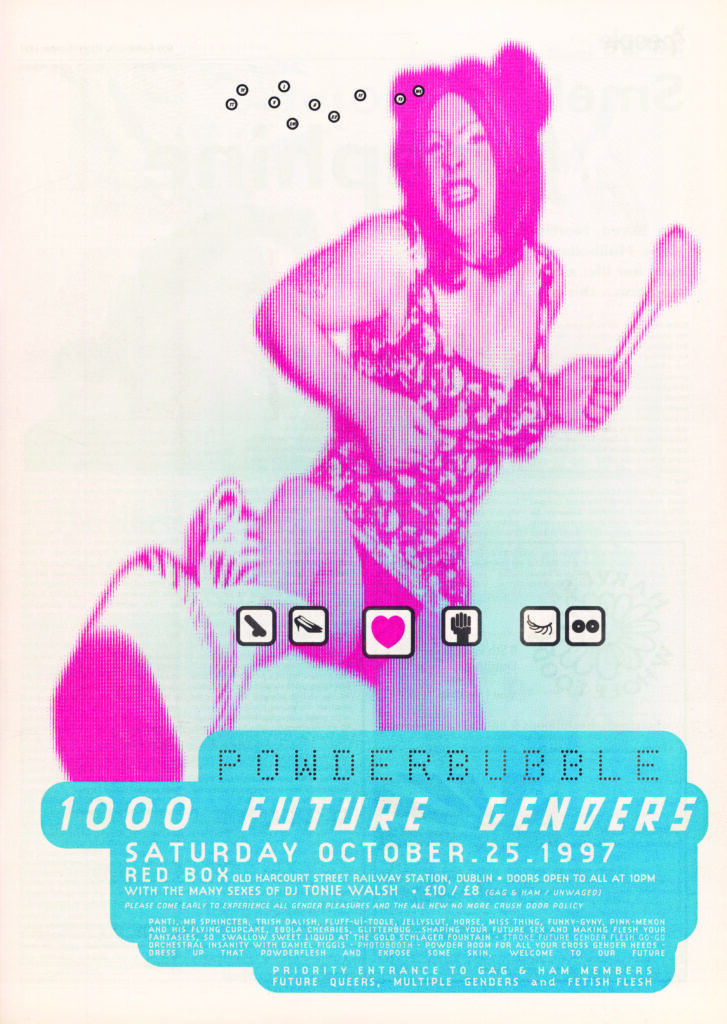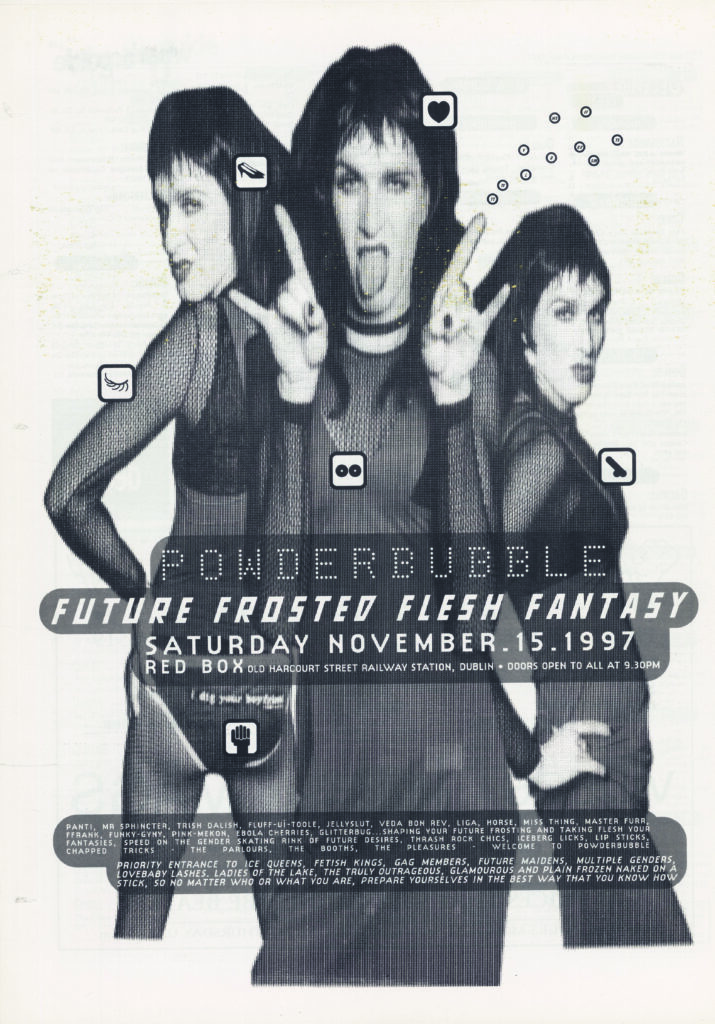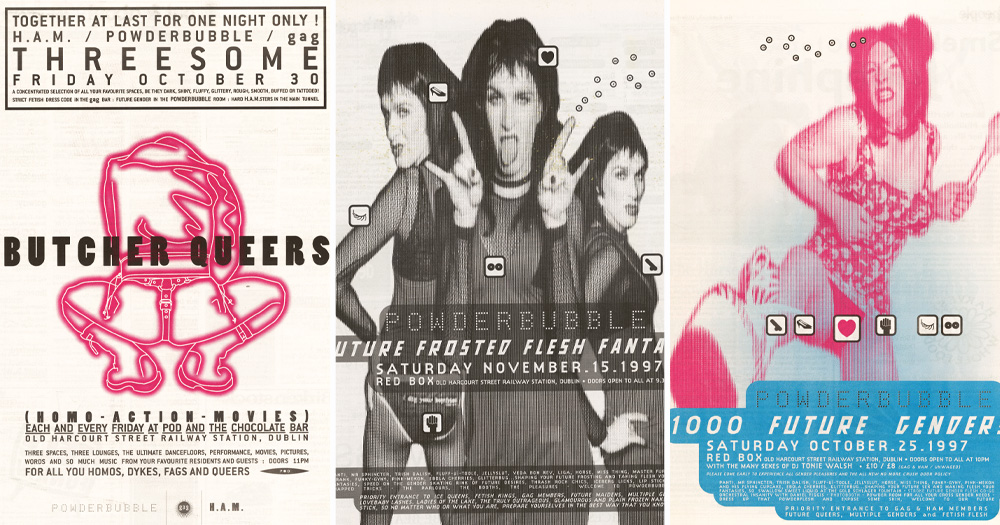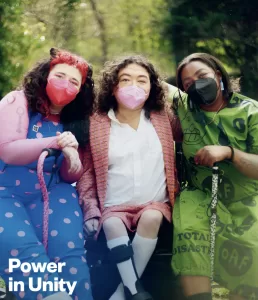To write the history of H.A.M. is to write the history of one of the most significant chapters in the social and cultural fabric of Dublin. Han Tiernan explains how its evolution would irrevocably shift the club scene and queer nightlife and would leave an indelible mark on Irish theatre, drag, culture, art, and even graphic design.
Nestled beneath the vaulted ceiling of POD nightclub in the former Harcourt Street train station, H.A.M. – or, to give it its full title, Homo-Action-Movies for Butcher Queers – delivered a new sensibility in how it approached clubbing.
In an NCAD interview in 2021, co-founder Niall Sweeney described how the new weekly club “was serious!”
“(H.A.M.) was serious about its music; it was serious about dancing; it was serious about the joy and coming together of that. It was serious about the dancefloor. And it was also serious about the artistry and the installations we used to do.”
But this new-found seriousness was a departure for Niall and his colleague Rory O’Neill, now better known by his drag persona, Panti Bliss, from the previous club nights they had run.
The pair first met at art college over a decade before H.A.M. came to fruition. As the only two out gay guys in the college, as far as they knew, the pair began to hang out in Sides nightclub, which was co-owned by Niall’s older boyfriend, Frank Stanley. But it wasn’t until Rory moved to Japan, that they really solidified their friendship.
In the days before the internet and mobile phones, they used the height of high-speed technology by communicating via faxes. Rory would send a fax to Niall’s work machine asking if he was alone in the office. Niall would inevitably assure him he was, whilst he and his colleagues would huddle around to inspect the slew of Polaroid pictures from the nightclub Panti was performing at. Slowly spooling out in saturated monochrome, they would eventually decipher Panti sitting on a well-suited businessman’s lap or being involved in similarly debaucherous behaviour.

Whatever Niall’s colleagues made of the madcap antics, the unconventional correspondence sealed the bond between the pair, paving the way for what would become a life-long friendship and artistic collaboration that would change the face of Dublin’s queer scene.
The political and social landscape of Dublin shifted significantly in the early ‘90s. As well as the decriminalisation of homosexuality, new licencing laws paved the way for a burgeoning club scene. Not one to miss a beat, DJ and LGBTQ+ activist Tonie Walsh recognised the appetite for a new genre of club culture and established Elevator in the Ormond Multimedia Centre. Having previously worked with Niall on GCN, he co-opted him to design and run projections on the nights.
Around the same time, Rory had just moved back from Japan and was staying with Niall and Frank. He began trying to carve out a name for himself in drag, an almost insurmountable task, as there were essentially no paid opportunities for drag queens in Dublin.

In his memoir, Woman in the Making, Rory explained, “I found out what seemed to be the fun, happening club nights, and I went to all of them in drag and made myself the most fun, memorable person in the room. It wasn’t hard – most of Dublin had never even seen a drag queen.”
At the time, queer culture hadn’t yet hit the mainstream, so anything slightly more subversive was relegated to Monday or Tuesday nights. One of the most popular of these was Strictly Handbag at the Kitchen nightclub.
Rory continued, “For a few weeks I went every Monday and made myself the life and soul of the party, climbing on the bar, being fun and causing a commotion, and then I proposed to the promoter, Martin, that I would keep coming every week if he paid me. And, knowing a fun mess when he saw one, he did.”

Niall and Frank decided to capitalise on Panti’s newfound popularity. Frank was the creative director of Makullas, a large-scale retail store on Suffolk Street. Its contemporary branding and style specifically targeted club culture. For Christmas 1995, the team commissioned Niall to create a campaign. He began by hanging a 20-foot photograph of Panti on the side of the building with a flashing arrow pointing down to the store window. In the photograph, Panti was wearing a naughty Mrs Claus dress that barely came down to her hip, revealing her stark black knickers, which some disgruntled Dubliners mistook for exposed pubic hair.
In the window, Panti could be seen swinging from a Christmas bell, where the public could communicate with her via an intercom. The exhibition became so alluring that bus drivers took it upon themselves to unofficially relocate the bus stop to outside the shop just so they could catch a glimpse.

Spurred on by the success of the Makulla’s campaign and inspired by Elevator, Niall and Panti decided to create their own style of club. Initially, GAG was a sort of fetish night attracting mainly leather and rubber fans, but quickly, the debaucherous reputation of Niall (AKA Mr Sphincter) and Panti’s performances meant everyone wanted in on the action. So the style shifted to people arriving in tennis whites and full Victorian riding outfits.
In an interview in the Science Gallery with the pair in 2015, Rory shared, “The idea of the party was that anybody could come… Our dress code rule was, ‘If we believe that you think this is sexy, we’ll let you in’.” He also recalled one of his favourite moments when a naked reveller claimed to have lost his clothes during the night, so the burly bouncer fashioned a dress using bin bags and a stapler, handed him some cash and put him in a taxi.
The first GAG took place in the Tivoli Theatre, but they were quickly booted out. After making the front-page headline ‘Dublin Sex Orgy Sensation’ on account of Mr Sphincter’s gallant efforts at pulling a string of pearls from Panti’s derriere, they were also booted out of their second home, The Ormond Multimedia Centre. They eventually found new lodgings on the then dilapidated Sir John Rogerson’s Quay, where they remained. For the club’s final night on October 27, 1996, marking its first birthday, Panti turned Niall into a giant birthday cake.

GAG cemented Niall and Rory’s reputation for producing some of Dublin’s most spectacular parties. And after successfully relaunching the Alternative Miss Ireland pageant with their colleague Trish Brennan in March 1996, they were the true darlings of the city’s club scene.
Later that year, music promoter John Reynolds approached them about running a club night in the newly opened Redbox above POD. The venue had a capacity of 1,500, meaning the night would need to be even more ostentatious than anything before. Along with a team of friends, they formed POWDERBUBBLE and less than two months after finishing GAG, they were back in business.
POWDERBUBBLE was all about the participants. It was about being the most showy you could be, about having an excuse to party and not just about coming out to see what everyone else was doing. Each month would have a new theme, which would be heralded by uniquely designed flyers, sporting images such as Panti riding a phallic-looking space rocket with the slogan, “Put more tooty in your booty – Here begins your Future Frooty”. Niall wanted them to be keepsakes not just promotional material. Something revellers could pull out of their pockets months later to remind them of the night.
Installations ranged from cladding the entire venue in real trees — at the despair of the fire safety inspector — to hanging hundreds of lilies from the ceiling, to creating an underwater theme with a life-sized model of a basking shark and ten inflated dolphins flying across the dancefloor. On one occasion, Panti even sauntered through the crowd on horseback.
With POWDERBUBBLE’s overwhelming success, Reynolds offered them a weekly Friday night slot in POD, so on February 14, 1997, they launched H.A.M. The new club signalled a watershed moment in queer culture for the city. H.A.M. marked the first time a mainstream club venue had given up its coveted weekend spot to a specifically queer event, and on a weekly basis, no less.
As Niall described, “After that, there was an excitement and a buzz, and people saw this whole idea of transgressive dressing up… just this idea of being able to establish yourself and create your own stage to dance upon. And even the idea of dancing in itself and dressing up as a political act – whilst having fun – actually became part of our day-to-day.”
H.A.M. ran successfully for eight years. During that time, H.A.M. spawned a monthly pre-club show called Gristle, where Panti nurtured other drag performers. This eventually led to her opening her own bar on Capel Street. Niall moved to London but continues to collaborate with Panti to this day.
While the days of GAG, POWDERBUBBLE and H.A.M. may have passed, there is no denying their impact is still felt in club culture to this day.
© 2024 GCN (Gay Community News). All rights reserved.
This article was published in the print edition Issue No. 383 (April 1, 2024). Click here to read it now.
Support GCN
GCN is a free, vital resource for Ireland’s LGBTQ+ community since 1988.
GCN is a trading name of National LGBT Federation CLG, a registered charity - Charity Number: 20034580.
GCN relies on the generous support of the community and allies to sustain the crucial work that we do. Producing GCN is costly, and, in an industry which has been hugely impacted by rising costs, we need your support to help sustain and grow this vital resource.
Supporting GCN for as little as €1.99 per month will help us continue our work as Ireland’s free, independent LGBTQ+ media.

